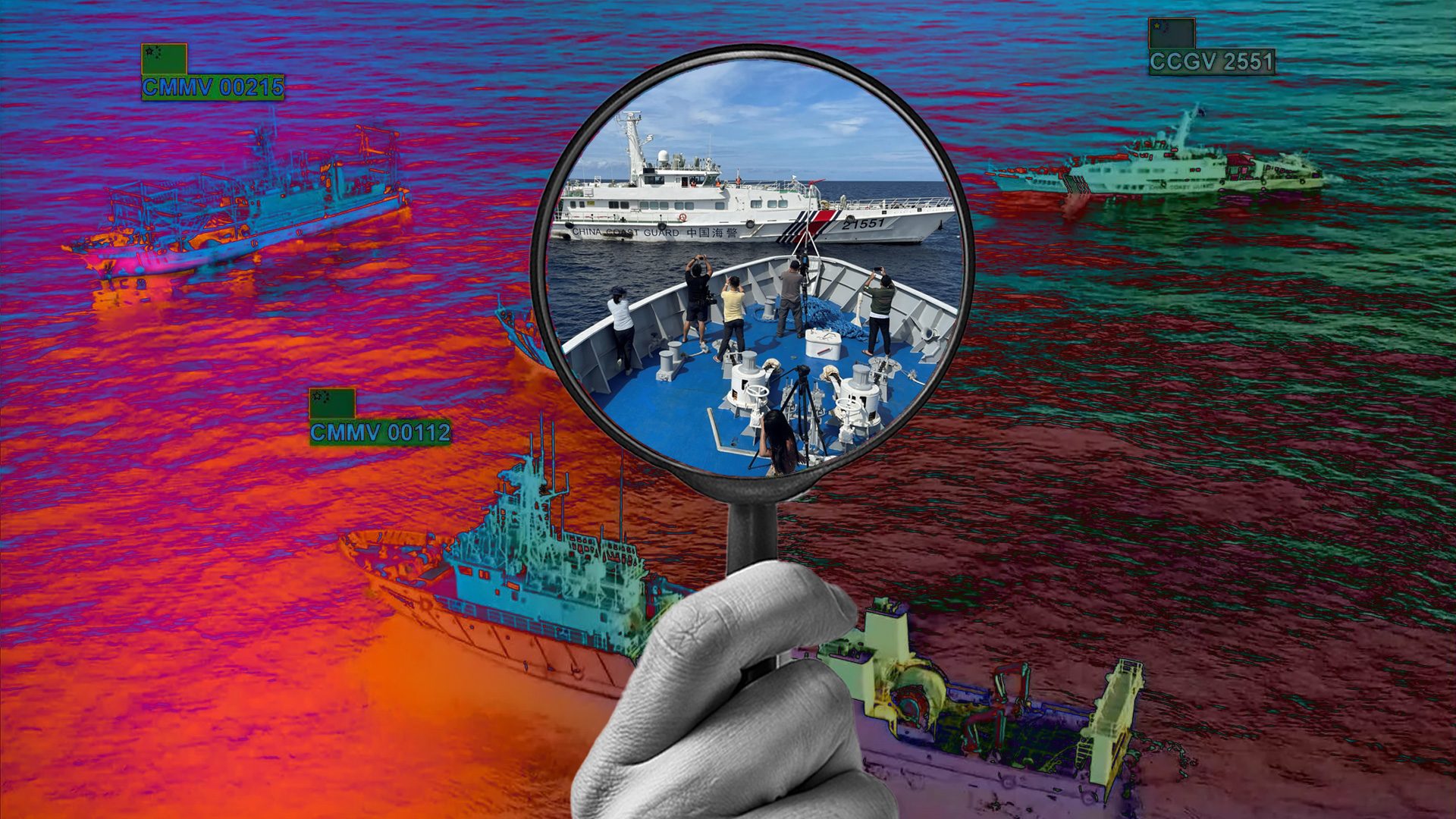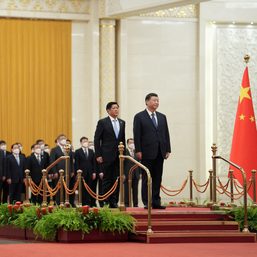SUMMARY
This is AI generated summarization, which may have errors. For context, always refer to the full article.

Flashpoints are Ayungin and Scarborough shoals, Reed Bank
In an old, quiet low-rise apartment building near Malacañang, after climbing the narrow wooden stairs to the second and third floors, modern offices surprise you: freshly painted and renovated, complete with conference rooms and TV monitors, sleek new desks, and swivel chairs. Bright and well lit, some parts are draped by the morning sun as uniformed men and women from the Philippine Coast Guard (PCG) bustle about preparing for their office’s blessing.
A ribbon on a colorful standing wreath announces the name of this brand-new office: “Office of the Special Staff on the West Philippine Sea.” This is where the PCG spokesperson on the West Philippine Sea, Commodore Jay Tarriela, and his staff moved to. Before this, Tarriela’s job as spokesperson on the WPS was merely added to his other duties, mainly as head of the human resource management.
It is January 2024, almost a year since the government began to make China’s aggressive behavior in the WPS public. There is anticipation in the air as Tarriela and his staff change gears and devote full-time attention to the WPS, a wide information arena to navigate.
A convergence of factors led to the creation of this new office: the change of leadership in the Coast Guard – the new commandant’s reorganization – and the national security adviser’s unrelenting emphasis on shining the light on China’s incursions in the WPS. As NSA, Eduardo Año, a retired general and former armed forces chief of staff with an extensive background in intelligence, also heads the National Task Force for the West Philippine Sea (NTF-WPS), an inter-agency body that coordinates policy and strategy.
This tactic of calling out China and letting the world know how this big power bullies its small neighbor has since been called many names: “assertive transparency,” “measured transparency,” and “strategic transparency.” Taking off from these, the new Coast Guard office recently renamed itself to “West Philippine Sea Transparency Office.”
The goal, really, is twofold: First, to make the Filipinos aware of China’s illegal presence and dangerous maneuvers in the WPS, which deprive our fishermen of their livelihood and violate our country’s sovereign rights. Second, to garner international support and help enforce the 2016 arbitral ruling that declared China’s nine-dash-line claim on the South China Sea illegal.
Not so long ago, in February 2023, the first spark of what was then called a “transparency initiative” lit up the WPS. The trigger: China aimed a military-grade laser at a PCG ship accompanying a Navy resupply mission to Ayungin Shoal, causing temporary blindness to the crew at the bridge of the ship. There at the shoal, a decrepit World War II ship, BRP Sierra Madre, stands guard, manned by a small team from the Marines.
The Coast Guard provided videos and photos of this incident and the Department of Foreign Affairs (DFA) lodged a strongly worded diplomatic protest against China.
Turnaround
Looking back, Tarriela said in a recent forum that the transparency initiative went through “birth pains as skeptics questioned its objectives.” At the time, the government was still adjusting to the shift from predominant silence or selective disclosure during the Duterte administration to a complete turnaround under President Ferdinand Marcos Jr. Tarriela credits Año for carrying the ball, never wavering in their campaign which included embedding Filipino TV, online, and print journalists in the resupply missions, as well as those reporting for the wires and international news organizations.
Skirmishes with China, which continued during the monthly resupply missions in Ayungin Shoal, intensified the transparency efforts of the government, leading to an unprecedented joint press conference on the WPS by the DFA, Coast Guard, Armed Forces, and the National Security Council (NSC) in August 2023. This, after China fired water cannons on PCG and Navy-operated vessels.
Jonathan Malaya, NSC spokesperson, said in a recent webinar that the transparency tactic is “our way of pushing back against China.” How would he assess the campaign, so far? “Mixed success,” he replied. They have raised awareness in the Philippines and internationally “but this has not changed China’s behavior.”
What next?
Initially, the focus was heavy on Ayungin Shoal because of Chinese maneuvers to thwart and intimidate the regular resupply missions. The atmosphere became quite tense for a while but the temperature has since cooled down after the NTF-WPS shifted its attention to another flashpoint, Scarborough Shoal. This is where Filipino fishermen continue to be harassed by the China Coast Guard and maritime militia.
Last week, satellite images showed a new floating barrier at the mouth of the shoal, months after an earlier one was dismantled by the PCG. This appears to be a response to the PCG’s and the Bureau of Fisheries and Aquatic Resources’ routine deployments of their vessels to the area to accompany fishermen, providing them fuel and food.
Reed Bank, rich in oil and gas, is another potential flashpoint that is on the radar of the NTF-WPS transparency initiative. In the Duterte administration, China and the Philippines failed to negotiate a joint exploration deal. China refused to abide by the terms of the service contract which, among others, required them to implicitly recognize Philippine sovereignty over Reed Bank.
The Philippine Navy is catching up, recently designating its own spokesperson on the WPS to widen the conversation beyond China’s gray-zone tactics and train the spotlight on the Navy’s activities in the WPS.
Overall, the transparency campaign has received rave reviews: a Western diplomat called it a “stroke of genius” and a US think tank said it is a “game changer.” In a study, Raymond Powell and Benjamin Goirigolzarri of the Gordian Knot Center for National Security Innovation at Stanford University said that the Philippines “rewrote the counter-gray zone playbook,” describing it as a “potentially revolutionary innovation…worthy of study and emulation…” The challenge, Powell and Goirigolzarri wrote, is “whether the Philippines can effectively sustain and leverage it into a broader gray zone strategy…”
The big ask is: Will the Philippines be able to institutionalize it? Will the transparency initiative continue under a new administration? After all, the maritime dispute with China transcends the terms of presidents.
Let me know what you think. Please email me at marites.vitug@rappler.com. – Rappler.com
Add a comment
How does this make you feel?










![[Just Saying] SONA 2024: Some disturbing points](https://www.rappler.com/tachyon/2024/07/TL-marcos-sona-points-july-23-2024.jpg?resize=257%2C257&crop=335px%2C0px%2C720px%2C720px)

There are no comments yet. Add your comment to start the conversation.